| You'd See His Hand
Come Up Over The Piano And Take A Drink. Continued
It was not just the public houses that provided
opportunities for the groups to play during the 60s,
there was also a considerable number of local dance
halls and hotels available. Some of those dance halls
and hotels became very closely linked with the
development of the group scene. In Wolverhampton itself
it is possible to separate these venues into two
chronological periods, pre-Beatles (1959-1963) and
post-Beatles (1963-1969). The earlier period would
definitely include the Scala
in Worcester Street and the two Temple Street
venues, the Dorchester and the Regent (Palais
de Danse). The second period would include the
Woolpack in Cleveland Street, the Connaught
on Tettenhall Road, the Park Hall on Goldthorn
Park. Perhaps the Civic and Wulfrun Halls
and the Queen's ballroom could be included in
both periods.
Further afield
from Wolverhampton there were venues like the Plaza
at Old Hill, the Ritz at King's Heath, the
Plaza in Handsworth, Bilston Town Hall, the
Pipe Hall in Bilston, Coven Memorial Hall,
Brewood Jubilee Hall, the baths at Willenhall,
Darlaston and Bloxwich, the Adelphi
in West Bromwich, the Majestic in Wellington, the
Rose Marie in Bridgnorth and the Queen Mary
in Dudley. Each and every one of those listed played
their individual part in the local music scene of the
1960s. It is impossible to cover all of those venues but
I have chosen to concentrate on a few of them.
The Scala
began life as a cinema in 1913 and continued showing
films for over sixty years. Like so many other town
centre cinemas however, it suffered during the general
decline in cinema-going and so had to change its
function. One of its new roles was as a dance hall and
it was as such that it enters the story of the local
music scene in the 60s.
While the Scala
was never a venue for the beat groups which emerged
during the mid-60s, it was very much a place to go if
rock 'n' roll was the preferred taste. It was at the
Scala that some of the area's earliest rock groups like
Tommy Burton's Combo, Dixie Dean's Combo,
Clive Lee & Phantoms and the original Black
Diamonds regularly played. It was one of the first
dance venues to have nationally known performers, like
Billy Fury, Nelson Keen and Vince Eagar make live
appearances. It still evokes interesting memories
amongst some of its 'rocking' customers:
"It was
regarded by me and mates of mine as a cut above the
Dorchester. It was also less likely to have trouble
there. It was the main rock venue as far as I was
concerned. It was the first place I ever saw Tommy
Burton, although it was not as the Combo. I think they
were called the Beatniks or something like that."
"The Scala
had been the nearest cinema to our house in Fisher
Street in Pennfields, so when it became a dance hall, it
was quite natural for me to go there. It used to have
dances on most nights." |
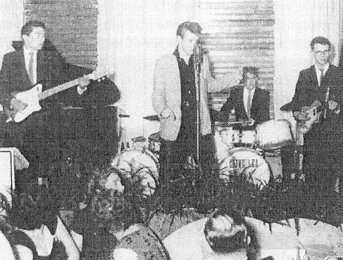
|
Clive Lea & the Phantoms.
Clive Lea was quite a regular visitor to the
Scala in the early days. He was another of
the Elvis 'move-alikes'. (Laurie Hornsby) |
|
"It had quite an imposing
frontage, like many of the old cinemas. It had a good
dance floor as well. It was at the Scala that I saw
Billy Fury who was my very favourite at the time."
"I saw most of the early local
groups at the Scala. I think there was one regular night
when local groups played. It used to be advertised as
the Rock Night. I saw Tommy Burton, Dixie Dean and the
Black Diamonds there. Dixie Dean really thought he was
an Elvis or a Little Richard. He wasn't too bad though
to be honest." |
|
"The stage at
the Scala was at the same end as the cinema screen had
been. It still had the arch over the stage. All the
dressing rooms at the Scala were at the other end. Some
of the early stars would have to cross over the dance
floor to get to the stage so they must have almost taken
their lives in their hands."
"One thing I
don’t remember about the Scala was whether the floor
sloped or not. I suppose it must have done if it had
been a cinema. It didn’t make any difference when you
danced there so perhaps it didn't slope at all."
|
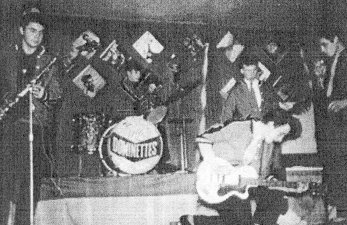
|
Steve Gibbons.
Seen here at the Scala (notice the LPs on
the back-drop) as lead singer of the
Dominettes. Steve is still performing and
producing great sounds. (Laurie Hornsby) |
|
|
The former
Woolpack is now part of the Wolverhampton Market
buildings but in the 60s it was definitely one of the
most successful venues for groups. In fact, many of the
group members look back on it as their favourite venue.
Graham Corns worked for PMA
(Perry/Maddocks/Allen) at the Woolpack, so he remembers
it very well:
"I started
there in about 1964, working for PMA which at that time
was in direct competition with Astra. Later of course
they were to work very closely together. The Woolpack
was a very successful venue, starting as one night
(Friday) per week and ultimately becoming almost a
nightly venue for groups."
"I was
responsible for the admission of customers, the security
and paying the groups at the end of the night. Most of
the groups would get about 12 quid, the better groups
got 15."
"All the
sessions started at 8.30 and groups had two fifty minute
sessions. The bar closed at 10.30 and the place had to
be empty by 11 o'clock. PMA leased it from the local
Council."
"The fire
limit was 257 and most of the groups would easily get in
that number, especially the 'N Betweens who were
probably the most popular of all the groups who played
at the Woolpack. Other popular groups were the
Californians, Finders Keepers, Montanas and Jam
Sandwich."
"Noise was a
constant issue at the venue, despite the Woolpack being
nowhere near a residential area. The problem was that as
the site was Council-controlled, it was even more
necessary for vigilance. It was very much part of my
responsibility to determine the level of sound otherwise
PMA would lose their lease on the venue."
"Most of the
punters who came to the venues were there to both dance
and listen. If the group was something like the 'N
Betweens then the music was more to listen to, while the
Montanas or the Californians played dancing music."
Many group
members fondly remember the Woolpack, as shown by the
following examples:
Bill Hayward
of the Montanas:
"It was my
personal favourite. It had a little stage in the corner.
You had to run through the crowd to get out of the
Woolpack. It was actually where I met my wife so it has
very good memories for me."
Jake Elcock
of the Montanas:
"It was
possibly the next most successful venue for the Montanas
after the Cleveland Arms. We always went down really
well there. It was a curious place in a way because you
had to go downstairs to the dance floor and come back
through the audience to get out again."
John O'Hara
of the Californians:
"It was my
favourite venue because of the very receptive audience.
We always went down well with the crowd. They loved the
Beach Boys stuff and always wanted more. That’s a really
great feeling when people like you enough to ask for
more."
John Howells
of the ‘N Betweens:
"We used to
go down well at the Woolpack. We started to play there
and some of the other more popular venues once we joined
Astra. I think we were one of the more successful groups
at the Woolpack. We certainly played there regularly. I
think it was mainly on a Tuesday or Friday night."
Paul King
of the Ides of March:
"Our style of
music did not really gel with the audience at the
Woolpack. We were blues and the audience at the Woolpack
was mainly pop oriented. In fact, one night we played
there and my future wife asked for her money back
because she was just not into the sound we were making."
Tony Perry
of the Strollers:
"When I was
with the Strollers we used to play the Woolpack on a
Tuesday night for a feller called Vic Kendrick. It was
always a good night and I though the Woolpack was the
ideal venue because of its central position so when the
group broke up and I went into promotion, I asked the
Council if I could organise a Friday night session. They
agreed and so it became one of PMA's first promotions."
|
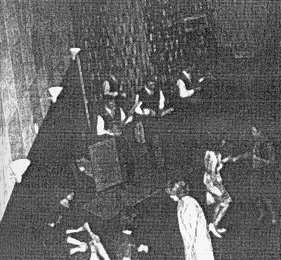
Soul Seekers.
The Woolpack (now part of the indoor market) had a very
distinctive appearance. Here we see the Soul Seekers in
their leather 'uniforms'. Were there only girls there?
(Graham Gomery) |
One memory,
which is shared by many of the regular customers who
went to the Woolpack, was the intense heat of the place,
especially in the summer when the hall was full. One
story, which is told by a number of people, is of an
evening when:
"It was so
hot that all the windows had to be opened and the
drummer with the group (unknown) got a little carried
away and started to play like Keith Moon. Anyway, he
disappeared because he had fallen out of the window,
followed by a fair amount of his Premier drum kit."
Another
successful PMA venture was the Monday evenings at the
Park Hall Hotel on Goldthorn Park. It became one of
the town's most celebrated venues, mainly as a result of
the many exceptional performers who appeared at the
hotel during the period. |
| In many ways the Park Hall was
the forerunner of the Lafayette and set some of
the standards for that club when it opened in September
1968. As Tony Perry recalls:
"The hotel was an ideal venue for dances, especially if
we had arranged for a big name to appear. It had the
sort of room we needed and could offer much better
changing facilities than most any of the other leading
venues. It was similar to the Connaught in size but we
had more big names there than at the Connaught, although
the Connaught used to have a good blues night on a
Sunday with people like John Mayall, John Hiseman and
Chicken Shack."
"If you
consider the names we had at the Park Hall it reads
rather like a who’s who of the 60s. We had David Bowie
do an acoustic set there, the Moody Blues played there
and we had to remove the side windows to allow them to
get their mellotron in. Others who were there included
John Mayall, the Searchers, Fortunes, Status Quo etc."
"Some of the
most exciting nights at the Park Hall were when the
Freddie Mack Showband played there. They had about a
dozen fellers in the group but they were tremendous.
They travelled around in a double-decker bus. We seldom
broke even with them but they were an incredible act."
"When the
Showstoppers played there they did not arrive until
about 11.30. Of course in those days there was no way
that you could get an extension for the bar beyond 11
o'clock, so we had about 400 people waiting for the
group but there was absolutely no trouble. They did not
get on stage until after midnight since they had to pray
in their dressing room first. When they did get on they
were great."
Another member
of PMA was George Maddocks and he has his own
special memories of the Park Hall:
"I used to go
round at the end of the night to collect the takings
from the various venues but I would often stay
throughout the Monday sessions at the Park Hall because
they were so good. We had so many great acts on. It's
quite amazing to think of the Park Hall Hotel in
Wolverhampton being the venue for some of the biggest
names of the decade."
"One thing I
always remember was that on a Saturday night at the Park
Hall we would often have members of the Wolves team here
and we would watch Match of the Day with them in one of
the hotel’s rooms, Players like Mike Bailey and Dave
Wagstaffe were quite regularly up at the Park Hall on
the Saturday."
"The night
that David Bowie played the Park Hall, his band did not
turn up so he did an acoustic set. He sat on a stool and
played guitar and sang to the audience. Tony ran that
gig on his own because I was away on holiday and Roger
was out of town. It was an incredible success
considering that David was a virtual unknown at the
time."
"I pulled
Robert Plant and the Band of Joy off the stage one night
because I thought he was awful. I remember telling him
that there was no way he would make it with that sound.
That must be one of the greatest mistakes of all time.
He actually pulled the aerial off my car that night
because he was so incensed."
Graham Corns
was often on the door at the Park Hall and he remembers
some of the nights at the hotel:
"The
Searchers played there at the time of the sugar shortage
and I remember John McNally telling me that he could not
get hold of any sugar. I went down to our house on the
Goldthorn Park estate and took him two bags. It was
quite funny when you consider that the Searchers came
from Liverpool, the home of Tate & Lyle."
"Other really
good acts who played the Park Hall were the Moodies, Hot
Chocolate, John Mayall and the Bluesbreakers, Status
Quo, Johnny Johnson and the Bandwagon and my personal
favourites, the Fortunes."
"The Park
Hall had some great nights with super acts on, but you
must never forget that some of the local groups were
often in support and often better than the main act. The
Montanas and the Californians for instance always put on
an excellent show at the Park Hall." |
|
"The noise
level was a particular problem at the Park Hall because
of its proximity to housing. In fact, it was probably
the noise that ultimately closed the Park Hall as a
venue for groups and live entertainment.
In my
experience the noisiest group we had at the Park Hall
was definitely the Band of Joy. Robert Plant had to be
warned a couple of times for the level of sound.
Imagine
telling the future lead singer of Led Zeppelin to keep
it down." |
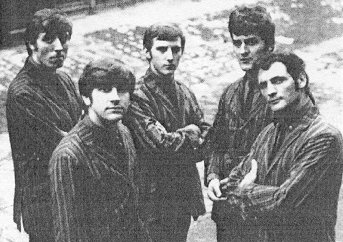
Moody Blues.
One of the most successful of the Brum groups to come
into Wolverhampton was the Moody Blues, even if they did
create havoc at times. Seen here with their original
lead singer Denny Laine (centre) (Jim Simpson) |
|
The Park Hall
also became one of the most successful disco venues.
When the 60s were coming to an end, and discotheques
were becoming the 'in' thing, the Park Hall became
possible the most important 'disco in town'. It was at
the Park Hall that many of the local DJs made their
name. Some of the regulars at the Park Hall discos
remember:
"I was never
really that keen on the local groups but the disco scene
in the town was very much my cup of tea. I remember
going to the Park Hall and the Connaught particularly
well. It was at those places that I best remember seeing
Barmy Barry, Sheiky and the General. They were great
nights."
"Some of the
earlier discos were on in support to some of the local
groups and others. I must admit as the time went on, it
was the disco which I went for, rather than the groups."
"The Park
Hall had a disco every week and we used to go up there
on the 26 bus. We would get off in Ednam Road or at the
top of Villiers Street and walk up to the ballroom at
the hotel. It was a great night there. I first met my
husband there."
"Barmy Barry
was the best of the DJs, no argument. He was head and
shoulders above the rest. I loved his humour and he was
so outrageous. Every time you went up to the Park Hall
or the Lafayette, later, you never knew what he would do
next."
While the venues
which we have so far considered were located in the town
of Wolverhampton, there were some which were as
influential but which were located a distance away from
the town. Probably the most important of venues was the
Plaza in Old Hill. Not one of the local groups
who achieved any success in the 60s failed to appear at
least once at the Plaza and for its legendary promoter,
Ma Regan.
Like the Scala
in Wolverhampton, the Plaza had been a cinema and had
stopped showing films when the decline in cinema-going
occurred in the late 50's. It had been a ballroom for a
time before Mrs. Regan took over, but once she moved in,
the ballroom became one of the most famous live venues
of the 'beat years'. If we were to consider the acts
that performed at the Plaza, we would be looking at a
virtual 'roll of honour' in British popular music of the
1960s.
The Plaza opened
as a beat venue in late 1962, in direct competition with
the Civic Hall in Old Hill. The Civic's promoter was Reg
Payton who apparently felt that the Plaza did not
present a really significant threat. Within two weeks
the Civic had abandoned its dance nights because of the
immediate success of the Plaza. Within a few months Ma
Regan was not just promoting at the Plaza in Old Hill
but also at the Plaza in Handsworth, the Ritz in King's
Heath and the Brum Kavern. She was able to hire some of
the biggest names from the period and managed several
Birmingham groups. It is not surprising therefore that
our own local groups were extremely anxious to get on to
the 'Regan circuit' and play at one or other of the
venues, especially the Old Hill Plaza, as the following
group members testify:
Roger Bromley
of the Soul Seekers:
"We actually
got on to the Regan circuit as Dane Tempest and the
Atoms. We were so intent on performing at the Plaza
because it had such an incredible reputation. It was the
place where every group who made it seemed to appear
first, around this part of the Midlands anyway."
"The first
time we appeared there it lived up to all of our
expectations. It had the revolving stage and so you
could make the big entrance and it had the knowledgeable
audience. It was a class above so many of the other
local venues, despite being in a virtual backwater "
"We played
one or other of the Regan venues several times but the
Plaza was always our favourite."
John Howells
of the 'N Betweens:
"We did an
audition for Ma Regan and got to play on her circuit of
halls. The most important to us and most every other
group was the Plaza at Old Hill because it had achieved
an almost legendary status because it had had almost all
of the big groups of the period on." |
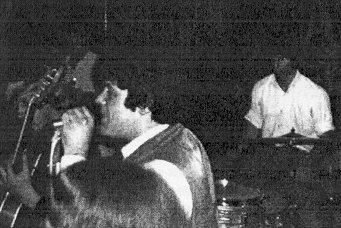
'N Betweens.
John Howells seen in the foreground with Don Powell on
drums and Dave Hill in the background. The venue is
probably the Milano in Darlington Street. (John Howells) |
"We got a virtual residency at
the Plaza at one time and so we were there when a lot of
the top names appeared. It never really lost its magic
and even the top-line bands realised that there was
something important about playing there, despite its
smallness and the relative remoteness of the hall.
When you consider the size of
Old Hill, it is amazing how important that dance hall
was in the whole story of the group scene in the West
Midlands." |
|
Jake Elcock
of the Montanas:
"I played at
the Plaza as a member of the Strangers and Finders
Keepers. At that time there were very few local venues
with more clout than the Plaza. If a group was thought
to be heading for success, then they had to play at the
Plaza. Ma Regan had a lot of influence at that time and
used it on behalf of several of the locally based acts,
especially those that she managed"
"The
revolving stage helped to give the Plaza that something
extra. No other venue had such a feature so if you came
round on that stage you felt that you were someone
important, or at least the group was important and on
their way, after all so many of the top groups had
played there."
''If you talk
to anyone who was directly involved with the music
business during the 60s, they will always mention the
Plaza. It had something which made it stand out for
everyone."
The Plaza may
have been in Old Hill and there may not have been
anywhere near as many cars available in the 1960s as
there is nowadays but many Wulfrunians were quite
regular visitors to the ballroom:
"I went over
there quite often on a Monday or on a Saturday. It was
definitely the big names which attracted me. I saw
people like Jerry Lee Lewis and Del Shannon there and it
was relatively cheap."
"The night
the Beatles played at the Plaza has almost become
apocryphal with many people claiming to have seen them
who just could not have done. I was there and I can
honestly say that they were excellent and did present a
sound which no other group could achieve at the time."
"Old Hill
Plaza was my favourite dance hall. It was the
friendliness of the place and the fact that Mrs. Regan
was able to get virtually everybody who was anybody in
pop music to play there. I saw groups like the Moodies,
Kinks and Manfred Mann there and it was relatively cheap
to get in."
"If you
played your cards right you could get to see some of the
groups twice in one night since most of them would play
at more than one of the venues. If you had a car you
could follow the group from the Plaza to the Ritz or the
other Plaza on the night."
"The Plaza
may not have appeared much from the outside, in fact it
was a fairly typical cinema frontage but once you got
inside you knew you were going to get a really good show
because the groups who were booked there were always top
quality."
"I remember
seeing Mrs. Regan numerous times at the Plaza, she
appeared to be something of a dragon but she could
certainly get some outstanding performers to play at the
hall. I reckon I saw the vast majority of the top acts
of the mid-60s upstairs at the Plaza."
"That
revolving stage was probably the most outstanding thing
about the Plaza. It had elements of the Sunday Night at
the Palladium about it. You know what I mean, the way
the acts used to go round on that stage at the end of
the Sunday night programme. When I think about those
days I find it hard to believe that I saw the Beatles,
Kinks, Jerry Lee Lewis and so many others at the Plaza.
How Ma Regan could get so many great acts on is amazing.
She certainly managed to make the Plaza at Old Hill a
very special place." |
 |
 |
 |
Return to
the
previous page |
Return to
the Contents |
Proceed to
the
next page |
|